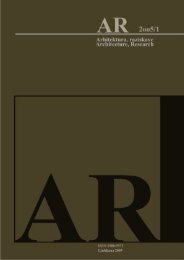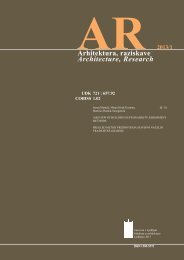Gergely NagyAR 2012/1 recenzija: Workers' neighborhoods and workers' cities 1750 - 1950construction, the development and the possibilities of preservingof the workers' cities in Baranya, Carinthia, Croatia, FriuliVenezias-Giulia, Upper Austria and Slovenia.Usually the aim of publishing the research results and studiesis the cognition and familiari<strong>za</strong>tion, as the basis. However, thisbook substantially exceeds this as it is written by specialistswho are experienced not only in the field of research but alsoin the practice of urbanism and of the protection of monuments.Accordingly they were able to overview the research resultsfrom a practical point of view. Besides the interpretation ofthe architectural and historic significance of the workers'neighborhoods and workers' cities the book concerns questionsof national monuments as well. In this case beyond the traditionalapproach of protection of monuments – because of the scale andthe context – the preservations have to be done according to anentirely new system of requirements. This has no elaboratedroutine yet, we can recline only upon general internationalcharters and principles. The volume is actually referring to therelated international agreements. Accurately estimating the localfacilities – based on the conservation principles of the ICOMOS– the book is even defining a conceptual preservation program. Itpresents the requirements of preservation in a general order thatafter being completed with the local peculiarities can become aprogram of renewal of the regions.Apparently the workers’ cities are the proofs of an era. Thebook is confirming – following the definition of the VeniceCharter – that not only those are national monuments that weredeclared to be one. We can read it from the authors of “TheInternational Charter for the Conservation and Restorationof Monuments and Sites” from 1964 that “the concept of ahistoric monument embraces not only the single architecturalwork but also the urban or rural setting in which is found theevidence of a particular civili<strong>za</strong>tion, a significant developmentor a historic event. This applies not only to great works of artbut also to more modest works of the past which have acquiredcultural significance with the passing of time.” Already the firststudies showed that the definitions of the Venice Charter fit tothe workers’ neighborhoods of the Alps-Adriatic region: so it isnot redundant to deeply engage in this subject. This modest butcommitted starting point led the project group to this volumethat opens up the possibilities to an entirely new research field.It needs to be continued because whoever outside the discussedregions reviews the work will realize that there are similarcomplexes in his neighborhood that were ignored before. Atmost sites drastic transformations rush the workers’ cities intodanger. Beyond the presentation of the architectural and historicsignificance the volume is destined to attract attention to thenecessity of their protection and preservation. With the help ofthe book of the Alps-Adriatic Project Group a new opportunityis opened up for the research of further workers' neighborhoodsand workers' cities because it gives the possibility of continuingand joining the project.Slika 1: Maribor. Železničarska kolonija (EŠD 448), Kurilniška, Koresova,Preradovičeva, Komenskega ulica, Južne železnice, 1863-1873.Figure 1: Maribor. Railway colony, South railway company * Südbanhof,1863-1873. [photo D. Zupančič].Slika 2: Maribor. Železničarska kolonija (EŠD 448), Kurilniška, Koresova,Preradovičeva, Komenskega ulica, Južne železnice, 1863-1873. Primervhodnih vrat.Figure 2: Maribor. Railway colony, South railway company * Südbanhof,1863-1873. Entrance sample. [photo D. Zupančič].43
Borut Juvanec2012/1 ARRecenzija knjigeZupanič, slavec, Z., (2011): Dosežki slovenskega gradbeništva (1918 – 1941)in stavbenik Josip Slavec. Unireal, Mohorjava družba, celje.iSBN: 978-961-218-989-1Knjiga je razdeljena na poglavja Življenje in delo stavbenikaJosipa Slavca in njegovih naslednikov, Gradnja mostov, Gradnjacest, Visoke gradnje, ima pa še Okvirni pregled del in sevedapovzetke, tudi v tujih jezikih.V prvem poglavju o življenju in delu Josipa Slavca je prika<strong>za</strong>noživljenje, razpeto med Avstroogrsko, staro Jugoslavijo,Jugoslavijo, vse do Slovenije. Že ta razpon je izjemen, posebejv strokovnem smislu, saj sega v dobo uporabe novih materialov,novih posegov in organi<strong>za</strong>cije dela, ne na<strong>za</strong>dnje v organi<strong>za</strong>cijipodjetja med cesarstvom in demokracijo. V opisu potekapodjetja je pomemben podatek o nadaljevanju v naš čas.Pomemben element Slavčevega podjetja je gradnja mostov, kjerje bil položaj gradbenika včasih drugačen od današnjega: obsegalje tehniko, izvedbo in inovacije, kar je omogočalo izvedbeključnih objektov, ki delujejo še danes. Med najpomembnejšimimostovi so mostovi v Zidanem mostu, zunaj domovine pamostovi preko Kolpe v Metliki in čez Liko v Kosinju. Kotstrokovnjak na področju gradbeništva je vodil dela na železnicimed Pragerskim in Kotoribo takoj po vojni, kar je <strong>za</strong>htevalovelike napore in znanje – tako strokovno kot organi<strong>za</strong>cijsko.Zanimiva predstavitev Tomaža Budkoviča je o gradnji cest, kjerso najpomembnejše reali<strong>za</strong>cije cesta na Vršič, med Podvinomin Lescami ter klanec v Kranju. Dobro pripravljen in korektnostrukturiran prispevek osvetljuje tako tehnične značilnosti kotorgani<strong>za</strong>cijska dela v stari Jugoslaviji.Za arhitekte je seveda najpomembnejše poglavje o visokihgradnjah, ki ga <strong>za</strong>okrožuje profesor Fister. Že v uvodu poudari,da gre <strong>za</strong> obdobje, ki ga bo treba šele definirati, saj obsega takodegradacijo in uničevanje kvalitetnega bivalnega okolja kotustvarja povsem nova merila <strong>za</strong> vrednotenje posegov v prostor,ki trajno in bistveno vplivajo na njegovo istovetnost. Gre <strong>za</strong> časvrste novosti, ki so izzvale spremembe vrednostnih meril ne lev tehnologijah, pač pa na področjih sociologije, ekonomije inpolitike.Predlaga razmislek o vključevanju Slavčevih del v našoarhitekturno dediščino. To podkrepi predvsem s primeri del vmestu Kranju, kjer je dober stavbenik omogočil, da je mestoohranilo svojo identiteto v pokrajinskem in vsebinskemmerilu. Fister umešča Josipa Slavca kot pozitivnega akterja priomogočanju razvoja in s tem kvalitete bivanja na področjih, kjerje treba imeti na razpolago res kvalitetne izvajalce.Med pomembnejšimi arhitekturami je niz individualnih hiš,predvsem pa so večji objekti kot so šole, hoteli (Jelen in Starapošta, Park hotel na Bledu, Šport hotel na Pokljuki), po vojnipa vodstvo del na naj<strong>za</strong>htevnejših objektih kot so Ravnikarjevaobčinska stavba ali objekt SDK v Kranju.Knjigo dopolnjujejta Okvirni pregled del in seveda povzetki,tudi v tujih jezikih.Knjiga je bogato opremljena z grafičnim gradivom, množicasoavtorjev <strong>za</strong>gotavlja raznolikost tekstualnega dela.Bolj strokoven in strukturiran izbor slik – v tehniškem smislu– bi nedvomno dopolnil kvaliteto obsežni knjigi, ki bi lahkopostala <strong>za</strong> gradbenike in arhitekte pravi učbenik tehnologij inizvedb. Strokovno poglavje z razlago tehničnih in tehnološkihrešitev bi bilo dobrodošlo. Posebej bi bili potrebni strokovniopisi inovativnih posegov, o katerih je v tekstu toliko napisanegain je v slikovnem delu dobro predstavljeno, a ni tehniškopredstavljeno, analizirano in ovrednoteno.Slikovno gradivo namreč odpira niz <strong>za</strong>htev po razlagi, ki bi –predvsem s shemami in risbami – umestila pomen in delo JosipaSlavca kot vrhunskega stavbenika svojega časa. To bi bilomogoče izvesti v enakem obsegu knjige, na račun preobsežihpolitičnih uvodnikov. Tudi skrbnejše lektoriranje bi pripomoglok vrednosti knjige.Dobrodošla knjiga odpira povsem nov pogled na stroko, kiobičajno ni predstavljena kot pomemben element posegovv prostor. Odpira problematiko, ki bo predvsem <strong>za</strong> arhitekte<strong>za</strong>nimiva, saj <strong>za</strong>polnjuje (navidezni, a tradicionalni) razkorakmed gradbeništvom in <strong>arhitekturo</strong>, kar je posebej pohvalno.44
- Page 12 and 13: AR 2012/1Martina Zbašnik-Senegačn
- Page 14 and 15: AR 2012/1Martina Zbašnik-Senegačn
- Page 16 and 17: AR 2012/1Martina Zbašnik-Senegačn
- Page 18 and 19: AR 2012/1Martina Zbašnik-Senegačn
- Page 20 and 21: AR 2012/1Martina Zbašnik-Senegačn
- Page 22 and 23: AR 2012/1Vanja Skalicky, Metka Sita
- Page 25 and 26: Vanja Skalicky, Metka SitarThe Conc
- Page 27 and 28: Vanja Skalicky, Metka SitarThe Conc
- Page 29 and 30: Amir Čaušević, Nerman Rustempaš
- Page 31 and 32: Amir Čaušević, Nerman Rustempaš
- Page 33 and 34: Amir Čaušević, Nerman Rustempaš
- Page 35 and 36: Gašper Mrak, Alma Zavodnik Lamovš
- Page 37 and 38: Gašper Mrak, Alma Zavodnik Lamovš
- Page 39 and 40: Gašper Mrak, Alma Zavodnik Lamovš
- Page 41 and 42: Gašper Mrak, Alma Zavodnik Lamovš
- Page 43 and 44: Gašper Mrak, Alma Zavodnik Lamovš
- Page 45: th9 mm folding11 mm backGergely Nag
- Page 49 and 50: AR 2012/1
- Page 51 and 52: Borut Juvanec2012/1 ARKULTURA DEDI
- Page 53 and 54: Domen ZupančičVrednote vernakular
- Page 55 and 56: Vojko KilarVARNOST PASIVNIH HIŠ PR
- Page 57 and 58: Vojko KilarVARNOST PASIVNIH HIŠ PR
- Page 59 and 60: Vojko KilarVARNOST PASIVNIH HIŠ PR
- Page 61 and 62: AR 2012/1
- Page 63 and 64: AR 2012/1Martina Zbašnik-Senegačn
- Page 65 and 66: AR 2012/1IzvlečekV prispevku so pr
- Page 67 and 68: AR 2012/1Na 33. zborovanju gradbeni
- Page 69 and 70: Navodila avtorjem2012/1 ARAvtor z o
- Page 71: AR 2012/1

















